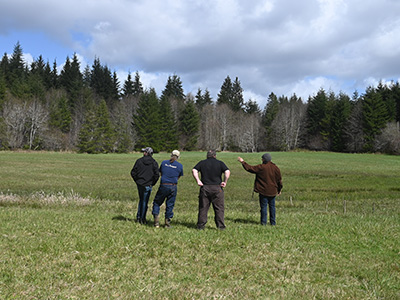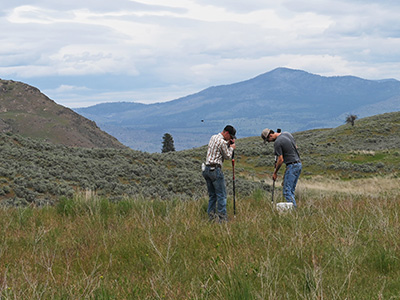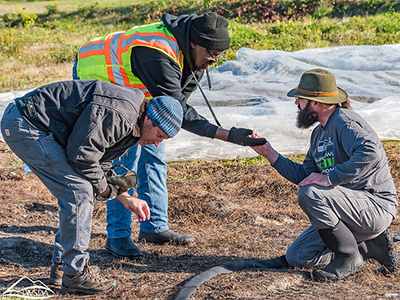Climate Resilience Plan for Washington Agriculture
Climate change creates new challenges for Washington agriculture, including extreme weather, wildfires, flooding, increased pest pressure, worker safety risks, and water supply volatility. However, Washington’s diverse geographies, cropping systems, state funding, and history of science-based innovations position it to adapt and remain resilient.
The purpose of the Climate Resilience Plan for Washington Agriculture is to support agricultural viability and vitality through ongoing and future climate change. Informed by extensive research and stakeholder engagement, the Resilience Plan proposes strategies to ensure that diverse agricultural stakeholders have the necessary resources for successful climate adaptation and enhanced resilience.
The purpose of the Climate Resilience Plan for Washington Agriculture is to support agricultural viability and vitality through ongoing and future climate change. Informed by extensive research and stakeholder engagement, the Resilience Plan proposes strategies to ensure that diverse agricultural stakeholders have the necessary resources for successful climate adaptation and enhanced resilience.
Section 1. Introduction and how to use this plan
This section provides background on Washington agriculture, the plan’s target audience, development process, and its connection to other state plans.
Section 2. Agricultural climate risks and adaptation opportunities
This section summarizes lessons from climate resilience plans, the latest science, and feedback from Washington's producers and farmworkers gathered through statewide engagement.
Section 3. Goals, strategies, and actions
This section outlines 6 goals, 14 strategies, and 27 actions to improve agricultural resilience, guided by 5 principles. Each action includes estimated timelines, budgets, collaborators, metrics, and related tools.
Appendix C: Engagement summary
Impacts of climate change on producers and other agricultural stakeholders.
Appendix D: Farmworker Engagement Summary
Impacts of climate change on farmworkers in Eastern Washington.
Versión en español.
Versión en español.
What is the main goal of the Climate Resilience Plan for Washington Agriculture?
The plan aims to support agricultural viability and vitality amid climate change. It provides strategies for farmers and other agricultural stakeholders to adapt to climate risks such as drought, extreme weather, and invasive species, while promoting resilience and innovation across the sector.
Who does this plan help?
The plan is for the Washington State Department of Agriculture (WSDA), agricultural stakeholders, including federal and state agencies, local jurisdictions, educational institutions, NGOs, farmers, farmworkers, tribes, and the private sector. Its aim is to coordinate efforts and provide resources to strengthen agricultural resilience across these diverse groups.
How was this plan developed?
The plan was developed through a combination of research, stakeholder engagement, and coordination with other climate initiatives. It included a review of existing climate plans, scientific studies on climate impacts, surveys, and listening sessions with stakeholders such as the Washington Grain Commission and farmworker organizations.
How does this plan align with other state efforts?
The plan supports the Washington State Climate Resilience Strategy and other state initiatives, such as House Bill 1170, by contributing agricultural strategies to statewide climate efforts. It also aligns with the Washington State Enhanced Hazard Mitigation Plan and the Washington State Department of Ecology's work on greenhouse gas emissions.
How will this plan address climate risks specific to agriculture?
The plan addresses risks such as drought, extreme weather events, and the spread of invasive species. It offers specific strategies for farmers to adapt to these changes through proactive measures, such as adopting climate-smart practices, improving operational resilience, and fostering sector-wide innovation.
What role does WSDA play in this plan's implementation?
WSDA will implement the plan by coordinating with various stakeholders, including state agencies, local governments, and the private sector. The department will also track the plan's progress, ensuring that it remains relevant and effective in addressing evolving climate challenges.
How will the plan ensure equitable support for agricultural communities?
The plan emphasizes inclusive engagement and collaboration with diverse communities, including with tribes, historically underserved farmers, and farmworkers, to ensure that their experiences and needs are considered. It also promotes the equitable distribution of resources to ensure all agricultural communities, regardless of size or location, can adapt to climate risks effectively.
What are the long-term goals of the Climate Resilience Plan?
The plan aims to increase the overall resilience of Washington’s agricultural system by ensuring farms remain viable in the face of climate challenges, fostering innovation, and reducing the environmental impacts of farming practices. Ultimately, it seeks to safeguard the state's agricultural future while ensuring sustainable growth and food security.
What is the role of research and education in the plan?
The plan prioritizes agricultural innovation through research and education. This includes supporting ongoing studies on climate impacts, fostering partnerships with educational institutions, and providing training for farmers to implement climate-smart practices that can enhance resilience.
How will the plan be evaluated and updated?
The plan includes an implementation and evaluation process that ensures continuous monitoring of its progress. WSDA will regularly update the plan based on new climate science, feedback from stakeholders, and evolving climate risks to ensure it stays relevant and impactful.
How does the plan address farmworker issues related to climate change?
WSDA worked with a Washington farmworker nonprofit to summarize lessons learned from their climate change engagement. The summary includes results from farmworker surveys and listening sessions, as well as the specific recommendations farmworkers made for a more climate-resilient future. Recommendations simultaneously aim to ensure worker safety and secure farm profitability through current and future challenges.









